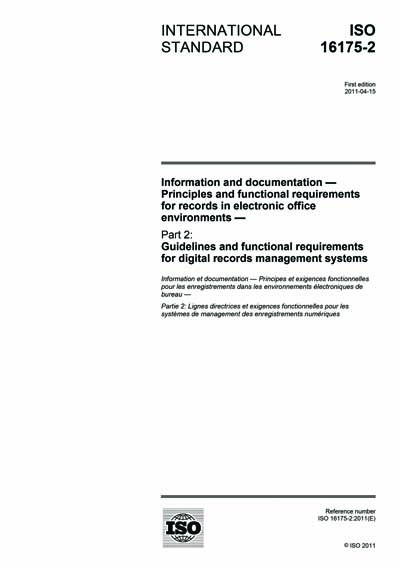Historical
ISO 16175-2:2011
Information and documentation - Principles and functional requirements for records in electronic office environments - Part 2: Guidelines and functional requirements for digital records management systems
ISO 16175-2:2011 is applicable to products that are often termed "electronic records management systems" or "enterprise content management systems". ISO 16175-2:2011 uses the term digital records management systems for those software applications whose primary function is records management. It does not seek to set requirements for records still in use and held within business systems. Digital objects created by email, word processing, spreadsheet and imaging applications (such as text documents, and still or moving images), where they are identified to be of business value, are managed within digital records management systems which meet the functional requirements established in ISO 16175-2:2011.
Records managed by a digital records management system can be stored on a variety of different media formats, and can be managed in hybrid record aggregations that include both digital and non-digital elements.
ISO 16175-2:2011 does not attempt to include requirements that are not specific to, or necessary for, records management, for example, general system management and design requirements. Nor does it include requirements common to all software applications, such as performance, scalability and usability. Given the target audience of ISO 16175-2:2011, it also assumes a level of knowledge about developing design specifications, procurement and evaluation processes, and therefore these issues are not covered in ISO 16175-2:2011. Nonetheless, the importance of non-records management functional requirements for records management systems is recognized through their inclusion is given in the high-level model for structure and overview of functional requirements.
ISO 16175-2:2011 does not give specifications for the long-term preservation of digital records; this issue needs to be addressed separately within a dedicated framework for digital preservation or "digital archiving" at the strategic level. These digital preservation considerations transcend the life of systems and are system independent; they need to be assessed in a specific migration and conversion plan at the tactical level. However, recognition of the need to maintain records for as long as they are required is addressed in ISO 16175-2:2011, and potential format obsolescence issues need to be considered when applying the functional requirements.
ISO 16175-2:2011 articulates a set of functional requirements for digital records management systems. These requirements apply to records irrespective of the media in which they were created and/or stored. The requirements are intended to:
- define the processes and requirements for identifying and managing records in digital records management systems;
- define the records management functionality to be included in a design specification when building, upgrading or purchasing digital records management systems software;
- inform records management functional requirements in the selection of commercially available digital records management systems; and
- review the records management functionality of, or assess the compliance of, an existing digital records management system.
International Organization for Standardization [iso]

